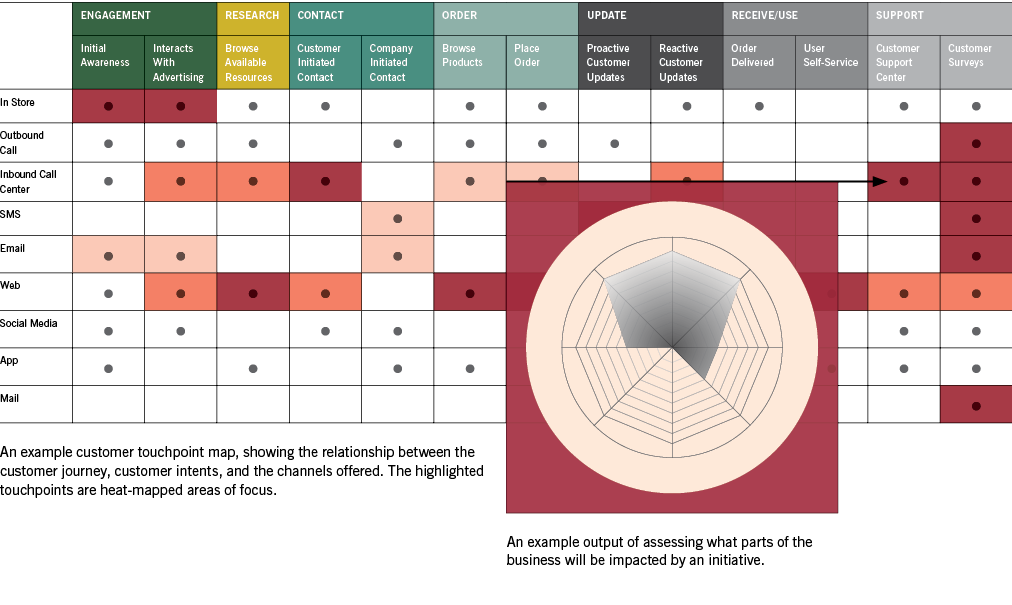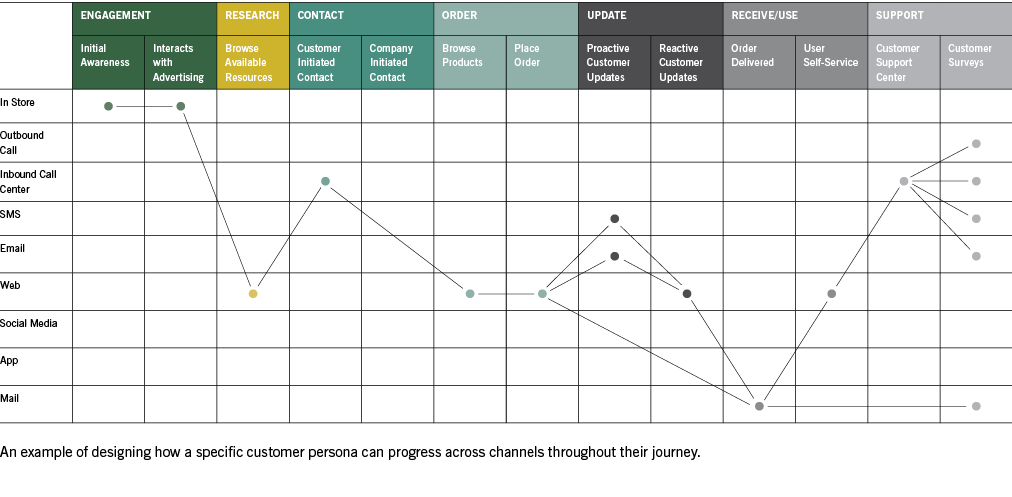But what was once magical is now mundane. As companies big and small have rapidly innovated in multiple channels, customers have come to expect an omnichannel experience as the rule, not the exception. Customers have moved from viewing a consistent experience as a “nice-to-have” to seeing it as prerequisite for giving you their business. A 2011 study by Oracle found that 86 percent of consumers will pay more for a better customer experience, and 89 percent began doing business with a competitor after a poor customer experience.1
The implication is that brands must do more than provide a consistent customer experience across multiple physical and digital channels.
Customers don’t have insights into a brand’s limitations on each available channel. Instead, they become frustrated when migrating across channels disrupts their experience. To provide exceptional customer service at every point in the customer journey, brands must evaluate how their customers move from one channel to another. Whether a customer selects an alternative channel or is intentionally shepherded from one to another, the customer’s needs must remain at the forefront of customer interaction design.
Enter the channel-less customer experience philosophy. By focusing on a seamless experience across channels, customer experience leaders can make it easy for the customer to engage. They can maximize the positive touchpoints customers have with their brand throughout the customer life cycle.
Solo acts versus a symphony
As customer experience demands pushed companies to interact with customers in different channels, a silo effect began to take shape. Companies would meet their customers in myriad channels but would tightly restrict what activities—and even what information—was available in order to tailor the interaction to the business’s capabilities. This was evident during the rise of online banking. Customers could find information or perform minor banking tasks independently while on the website, but still had to contact a customer service representative to report fraud or deal with account changes.
As digital customer channels matured, those restrictions were amplified by a large order of magnitude. With the rise of self-service and customization, consumer expectations grew exponentially with each digital innovation. Today, brands that don’t offer a wide array of capabilities to their customers on digital channels risk falling below the bare minimum level of expected service. Failing to provide consistent information across the entire customer journey only compounds the issue.
An obvious example of a company failing to meet customer expectations is Toys “R” Us. In 2000, Toys “R” Us agreed to a 10-year partnership with Amazon to be Amazon’s exclusive seller of toys and baby products. While the partnership was nominally successful, this meant that Toys “R” Us never developed its own independent online presence until 2006, after it won a lawsuit against Amazon. Toys “R” Us would not invest in growing its e-commerce capabilities until March 2017, mere months before filing for Chapter 11 bankruptcy in September that same year.
The challenge with siloed customer channels isn’t that your business needs to do every function in every channel possible. The challenge arises when channels operate independently, whether by habit as a business grows or by segmentation in the design process.
This fragments the customer journey as various “solo acts” unintentionally compete and cause conflict for the customer. Omnichannel strategies seek to address cohesion across all channels.
But cohesive experiences and consistent information address only part of the problem. The issue of how customers move across channels remains. What influences a customer to migrate from one channel to the next? How do the channels operate? Do they augment each other, work in parallel, or simply take handoffs from each other? Are there situations where customers are using two channels concurrently?
Who is blurring lines already?
The concept of orchestrating traditionally disconnected channels so they operate in concert is older than you might think. Consider the well-established B2B practice of ordering a product over the phone (or online) and picking up the product at a physical location. Those B2B brands instinctively knew that they had to provide customers very clear instructions for picking up their orders or using other channels to check the order status.
A successful channel migration experience lies at the heart of “buy online,” “pick up at store.” Though that experience is not exactly groundbreaking in the modern retail landscape, the principles that make it work provide a good foundation. The customer’s experience is at the forefront the entire time throughout the various business processes: sales, inventory management, order management, order fulfillment, and delivery to customer.
But while B2B has at least implicitly applied channel-less customer experience principles for a few decades, there are some exciting new innovations in the B2C space. The Walt Disney Company’s theme parks, an obviously physical experience, have introduced digital channels to augment and support the in-park customer experience.
Park attendees can use an app to buy tickets, reserve spots in line, and order retail merchandise for pickup. The physical and digital channels are not silos. They work together to relentlessly pursue an exceptional customer experience. Companies like Apple have also taken a lead in transforming the physical channel experience, augmented by digital channels (aided, of course, by their own product ecosystems).
Two major trends in retailing support the channel-less customer experience philosophy: digital-first companies offering brick-and-mortar experiences, and traditional retailers radically changing the nature of their physical locations.
Brands such as Bonobos and Warby Parker began as e-commerce companies that grew rapidly through successful lifestyle marketing campaigns. While masters of their digital channel offerings, these brands (and many like them) have chosen to expand their physical offerings through strategic retail locations and trendy “pop-up” shops.
These physical operations are capable of closing sales, but they’re structured more as a complement to their already successful digital offerings. Staff can guide customers across channels if the customer desires, and the products offered are staged as real-world examples of products customers can purchase online now or later.
Established brands such as Nike have taken note: Nike’s retail store philosophy has shifted from standard-fare retail offerings to a more museum-style experience. Customers traverse the store viewing products on display with special lighting and staged in interesting ways, with the intent that the customer consumes the content and is more informed to make a purchase. The purchase may not happen in store, but informational placards inform customers that these exact products are available on the web or through the Nike app.
Companies are doing more than just blending physical and digital channels. Digital-to-digital channel handoffs are ripe for innovation. An example is connected devices powered by intelligent virtual assistants such as Alexa or Siri. These digital-based AI helpers are creating exciting new ways for consumers to move across channels.
Need basic information? Ask Siri and she can tell you about it or show you on your mobile device. Not satisfied with Alexa’s answer? A bevy of other channel options are available, such as Alexa dialing a customer service line or presenting an FAQ page or web chat.
In a 2018 blog post, Werner Vogels, the CTO of Amazon, predicted that “the next generation of corporate systems and applications will be built using conversational interfaces.” Given the reach and breadth of Amazon in the cultural landscape, customers are already demanding Amazon-level experiences in their interactions with other brands in their personal lives and at work.
How can you value channel-less experiences?
The primary expected benefit of a channel-less customer experience is an increase in customer satisfaction metrics. The key driver of that improved satisfaction is the reduced customer effort to engage. Secondary benefits of this approach are increases in key metrics like repeat sales, net promoter scores, and customer lifetime values.
A multichannel strategy seeks to expand the number of channels offered, meeting customers where they are, but those strategies often leave the customer stuck if a channel fails to meet the customer’s objectives. Omnichannel done correctly should address those concerns and feel channel-less.
For a decade, customers have demanded a personalized, customizable, and consistent experience—regardless of the channel they are using. If a given channel cannot realistically meet customer expectations alone, then a channel-less customer experience strategy means enabling another channel to augment and fill any gaps. If business capabilities limit the ability to meet customer expectations, a channel-less customer experience can help customers migrate to a different channel that aligns with their expectations.
An ancillary benefit of a channel-less customer experience is reduced operational costs. When customers encounter roadblocks in their customer journey, it usually incurs costs for the business. These costs can manifest in operational areas such as customer service and support, sales support, IT support, or retention specialists.
No strategy can eliminate all possible problems for every possible customer persona. However, a channel-less customer experience philosophy that emphasizes channel migration and channel augmentation will open new paths for customers to achieve their goals. Intentionality in the design of these cross-channel touchpoints can drive customers to select self-service options more often, reducing the company’s spend on basic customer frustrations.
Figure 1

Figure 2

How to Make the Move to Channel-less
So, what does it take to break your omnichannel silos and move to a channel-less customer experience? First, start with three traditional activities common to most transformative projects:
- Review your current customer experience. (Figure 1)Reexamine your customer segments and the primary personas in those segments. Map out customer touchpoints across the various channels your company offers. Understand your customer journey and how your customer personas migrate across channels. Identify critical areas for focus. Establish teams to intentionally focus on channel-less design.
- Define the customer experience you want. (Figure 2)Be intentional. Focus on the migrations from one channel to the next. Think how your current or desired capabilities—in both the passing and receiving channels—work together to make the transition seamless. Consider channels that perform similar functions in the customer journey and note how those channels can augment one another. Eliminate fragmentation and help customers achieve their goals quickly.
- Develop a road map to achieve the desired customer experience. A well-defined current state and a heat map for areas of focus will make it easier to set a disciplined approach. Assess what resources your organization has and where it faces gaps to build the new customer experience. Prioritize the new features and capabilities to guide the implementation.
Once you have completed those activities and you’re ready to pursue channel-less strategies, take stock of your organizational landscape. Establish a governing body to keep the mission focused and disciplined. Empower that governing body to see across departmental lines and bring together the enterprise-wide cohesiveness that will make a seamless customer experience possible.
Commit to an organizational change that will allow cross-functional teams to form. Seek a culture that values multi-dimensional employee growth. Your people can still have their areas of expertise, but an emphasis on enterprise-wide operations and success will translate into success in customer-facing applications.
Finally, periodically revisit the customer journey in the context of the channel-less customer experience philosophy. Keep customer segments and personas current. Revisit cross-channel touchpoints as new innovations drive changing customer demands. Recognizing those changing winds and adapting your approach will keep the customer experience seamless across all channels.
Source
- “2011 Customer Experience Impact Report: Getting to the Heart of the Consumer and Brand Relationship.” Oracle Corporation, 2012. Accessed on 5/28/19 from: https://www.oracle.com/us/products/applications/cust-exp-impact-report-epss-1560493.pdf

 N
N